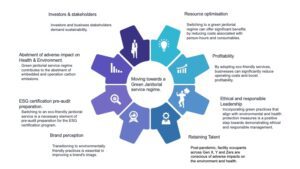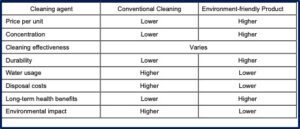Let us begin with a few interesting facts about Janitorial Services and Environmental Health.

Why Green Janitorial Service is essential to business?
Post-pandemic, facility occupants across Gen X, Y (Millennial), and ‘Zers are conscious of business operating practices that adversely impact health and environmental ecosystems. Beyond the need for compliance with local statutory and regulatory guidelines, investors, brand image for social responsibilities, and overall optimised business operating costs call for operating practices enhancing health and environment protection measures. Transition to Green Janitorial service from the conventional regime is given for business image and sustainability.
Economic, Social and Governance Drivers for Green Janitorial Service –

Successfully implementing a Green Cleaning regime requires overcoming common challenges.

To overcome the challenges listed, it is essential to design and implement tailored solutions that meet the unique requirements of each building’s application, including Energy Efficiency Assessment, Building Carbon Footprint Assessment, and Building Indoor Environment Quality Services.
Policy, Processes, Practice, and Profit
Policy, practice, and profit are critical elements of an environmentally friendly janitorial service regime.

Policy
Developing policies aligned with ‘Environmental Sustainability’ principles and complying with Green Cleaning standards, such as GS-42 or other equivalents, is essential to fostering an environment-friendly Facilities Management service. The successful implementation of sustainability objectives can be determined by a Service Level Agreement (SLA) with service providers for a commercial or institutional building, encompassing Energy Efficiency Assessment, Building Carbon Footprint Assessment, and Building Indoor Environment Quality Services.
Processes and Practices
A robust janitorial plan requires a governing standard and effective process. This ensures a clean, safe, organised space that promotes productivity and well-being. Developing site-specific processes, adapting them, and standardising critical elements of janitorial services is crucial for ensuring the best outcomes, including Energy Efficiency Assessment, Building Carbon Footprint Assessment, and Building Indoor Environment Quality Services.
As a good practice, when procuring cleaning materials, priority should be given to those that adhere to environmentally friendly guidelines and standards. Only cleaning products certified by globally recognised ecolabel certification programs, such as the Eco Global Label (NSO-NAP 3 standard), Green Seal Environmental Standard for Cleaning Services (GS-42) or EU Ecolabel, should be used. These products must be certified by a recognised institute for easy reference and verification. At least 75% of general-purpose cleaning items should be approved for environmentally safe usage, aligning with Energy Efficiency Assessment, Building Carbon Footprint Assessment, and Building Indoor Environment Quality Services.
When purchasing cleaning equipment, consider eco-friendly options and gradually replace high-impact equipment by assessing its carbon footprint and emissions, in line with Energy Efficiency Assessment, Building Carbon Footprint Assessment, and Building Indoor Environment Quality Services.
Profit
Cost is a paramount factor when considering the transition from traditional cleaning methods to eco-friendly alternatives. Specifically, labour, consumables, implements, and equipment comprise 75%, 15%, and 10% of the total cost of janitorial services. The optimisation of person-hour costs can be achieved through proper training, upskilling, and the efficient application of tools and equipment. Monitoring and analysing industry benchmarks and the facility’s baseline throughout the transitioning process will optimise the usage of cleaning agents. Waste treatment to upcycle or recycle contributes to operational earnings, supporting Energy Efficiency Assessment, Building Carbon Footprint Assessment, and Building Indoor Environment Quality Services.
An efficient green cleaning program must be tailored to the facility’s needs, and the outlined steps will result in a successful transition while keeping costs in check, incorporating Energy Efficiency Assessment, Building Carbon Footprint Assessment, and Building Indoor Environment Quality Services.
Comparison of cleaning agents between conventional and green cleaning methods.


